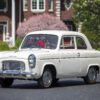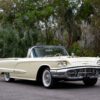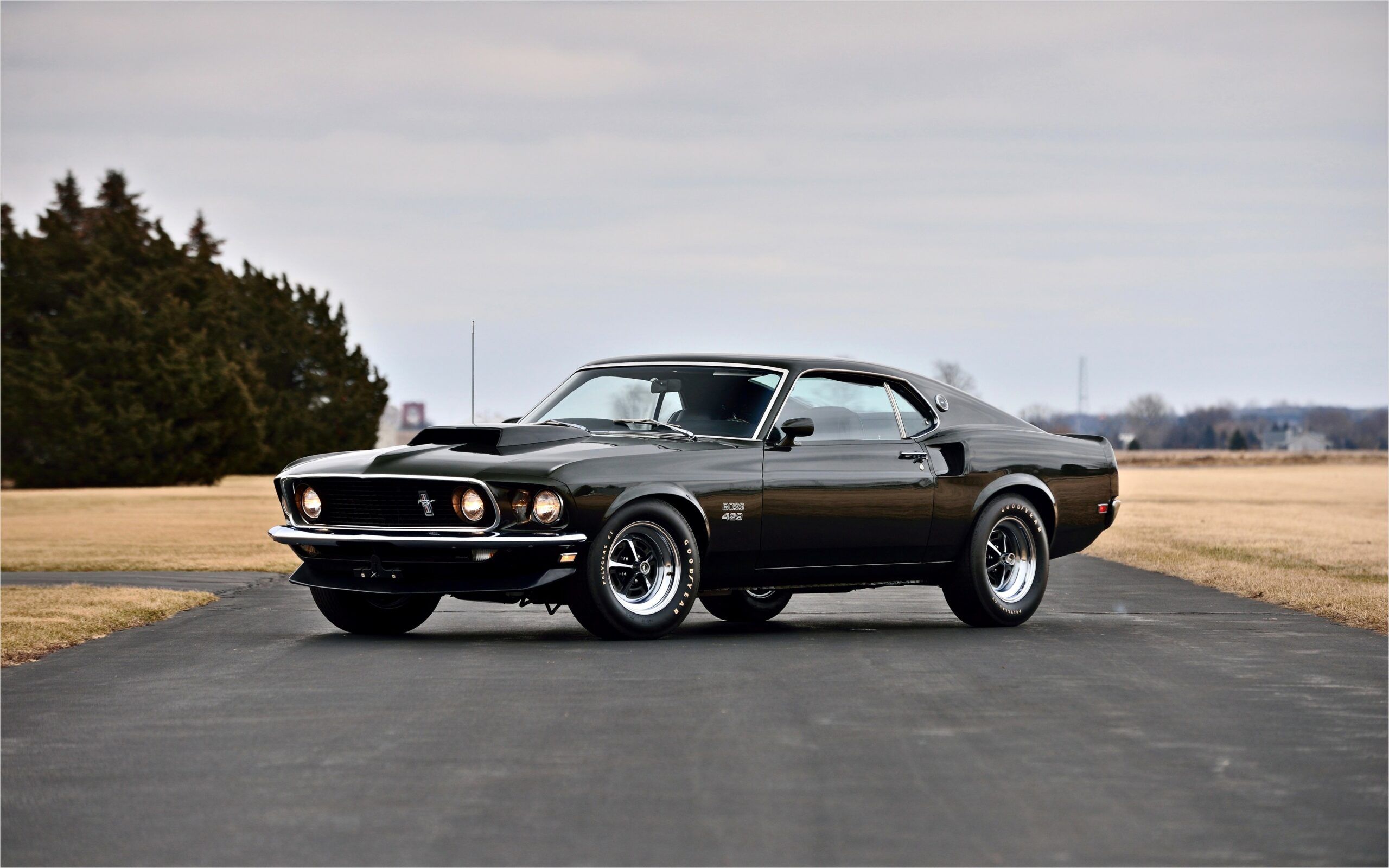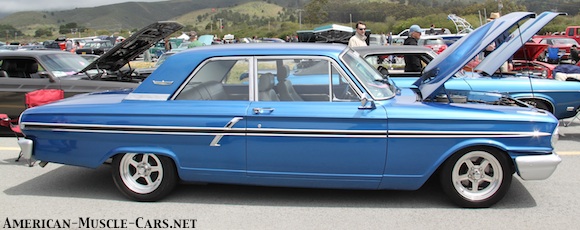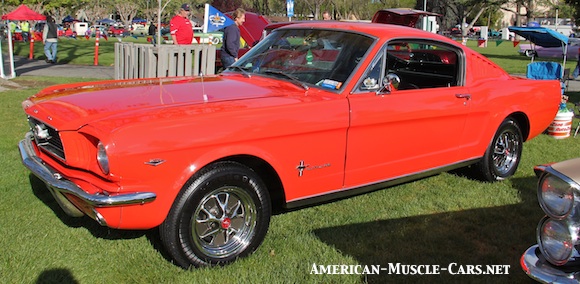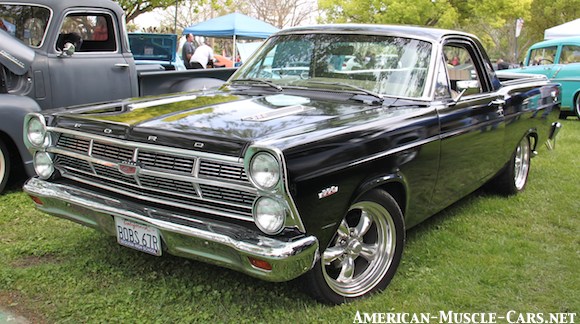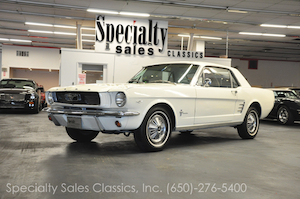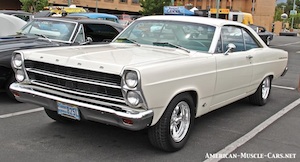Ford Muscle Cars

FORD MUSCLE CARS WIN RACES
Ford stormed through the 1960s flushed with racing success on the ovals of NASCAR and in International Racing Circuits that included LeMans, and at the Indy 500. There was no doubt they had the know how. And yet in the very early 1960s, Ford had little to offer performance junkies except their standard full-size and mid-size models (ie: Galaxy, Fairlane and Thunderbird) with big engines. Of course these cars were heavy, and the engines generally weren’t quite as powerful as the best from GM and Mopar. But, they were working on it.
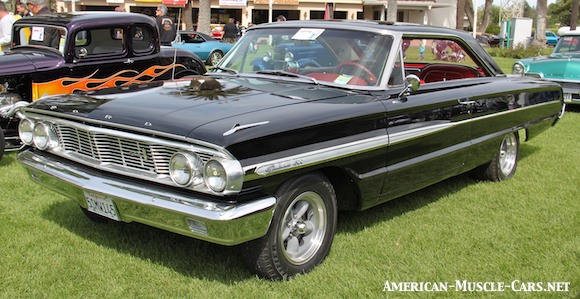
ABOVE: 1963 GALAXIE 500 with classic American mags (now called Turbo Thrust).
FULL-SIZED FORD MUSCLE CARS
The full-sized Galaxie and Galaxie 500 continued to get hotter and hotter engines throughout the early 60s. Starting with the FE 352, it quickly grew to a 390 which, with triple cars produced 401hp. By ’62, it had grown again to 406 cubes and 405hp. Then in ’63, it was enlarged further into the legendary 427 with as much as 425hp.
BELOW: 1964 FORD THUNDERBOLT. Only 100 of these souped-up Fairlanes were built, all with 427 hi-rise V8s with dual 4-barrels, to homolgate them for NASCAR.
ABOVE: 1966 MUSTANG FASTBACK with 271hp K-code 289 (not numbers matching).
FORD MUSCLE CARS – THE MUSTANG
It’s hard to describe to people today the impact that the Mustang had, back in 1964. No one had ever seen anything like it, and Ford sold a ton of them. It seemed they had hit the perfect sweet spot, a car for everyone, that looked sporty even if it had a 6-cylinder/3-speed. And while you could soon get a Mustang GT with a 271hp 289, it was no match for the pure muscle coming out of GM and Mopar. While the Mustang was a Pony Car, it wasn’t truly a Muscle Car. By this time, you could get a Chevy Chevelle SS with up to 375hp from its big block 396. Ford countered this in 2 ways. First they started working on cramming a big block of their own into the Mustang. And second, they started working on the rest of their muscle car lineup.
BELOW: 1966 MUSTANG SHELBY GT-350. Perhaps the Ultimate Mustang.
ABOVE: 1966 FORD RANCHERO with 390 V8.
FORD MUSCLE CARS IN ALL SHAPES & SIZES
Ford tried to cover the entire marketplace, and did a pretty good job of it. They started with their smallest model, the humble Falcon. By this time it had spawned the Ranchero pickup. Both were given the “GT-treatment”, with hot 289s and 4-speed trannies.
BELOW: 1966 FORD FAIRLANE 500 CONVERTIBLE. By this time, the Ranchero was based on the Fairlane platform.
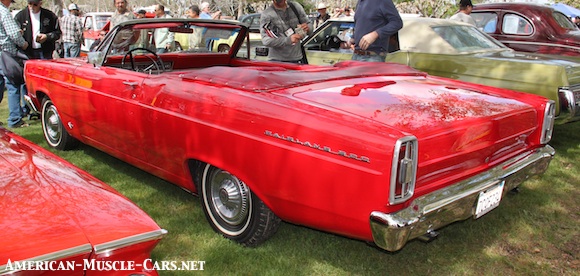
MID-SIZED FORD MUSCLE CARS
There was a real hole in the middle of Ford’s lineup, and this is where the action was. Chevy was lapping up sales with its Chevelle SS and Pontiac was selling every GTO it could build. Ford needed some of that action. Ford quickly crammed a big engine into the Fairlane and let her rip. It sold well enough, but it wasn’t until 1968 that Ford truly cracked the muscle car code. They did it by jamming a big block into the Mustang, first with a 390, then with the 428 CobraJet, creating one of the quickest stoplight warriors you could buy.
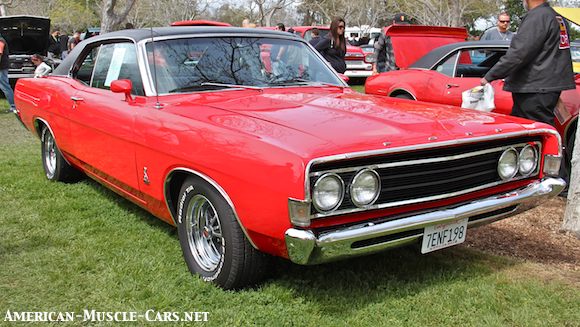
ABOVE: 1969 FORD TORINO COBRA with 428 CobraJet V8. Rare and very fast.
FORD MUSCLE CARS – THE TORINO
It was really the arrival of the stylish Torino that turned Ford’s muscle car fortunes around. Unlike the boxy, pedestrian styling of Ford’s mainstream Fairlane & Galaxie line, the Tornio sported a sexy, curvy shape, and soon it was packed with power, including the 428CJ and later the 351 Cleveland.
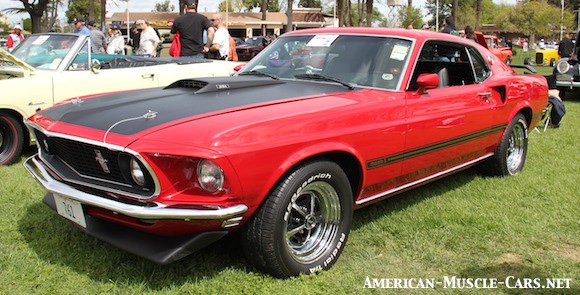
ABOVE: 1969 MUSTANG MACH 1 with Magnum 500 wheels & optional hood pins.
FORD MUSCLE CARS INTO THE 70’s
Like everyone else, Ford was forced to drop compression ratios, add power-robbing smog equipment, and bulk up the safety on their cars, and performance suffered. Across the entire industry, 1970 was truly the zenith of the Classic Age of the Muscle Car, and by ’71, power was dropping fast.
BELOW: 1993 MUSTANG COBRA. The last year of the Fox-body Mustangs.
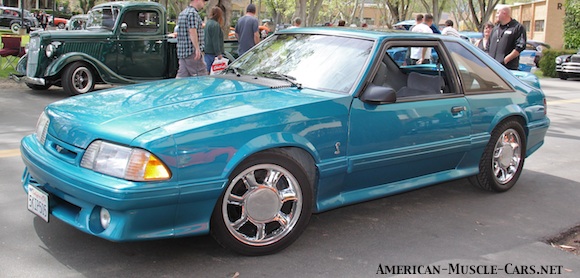
THE REVIVAL OF FORD MUSCLE CARS
It would take until about 1987 before horsepower would again start to climb in the Mustang. The advent of electronic engine controls and sequential-port fuel injection changed everything. Horsepower continued to climb through the 80s, 90s and well into the new millennium, now well-past 500 hp and climbing, with no end in sight. And all of this was accomplished while cleaning up the emissions and improving gas mileage! This is indeed the New Muscle Car Age we are in today.
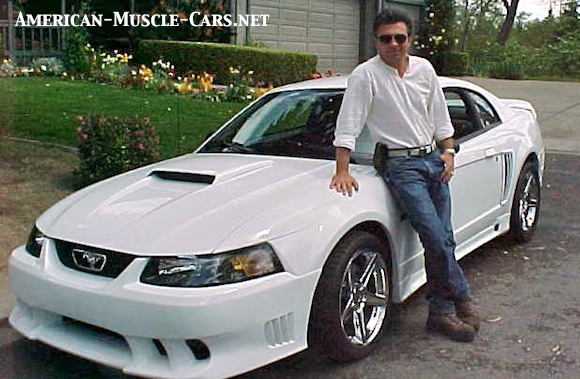
ABOVE: That’s me posing with a near-new 2002 Ford Saleen Mustang. I owned a classic car dealership at the time, and someone traded this one in, with only 300 miles on it. I drove it around…just a little (gotta keep those miles down), then sold it for a tidy profit. Very fast for the time.
BELOW: 2007 MUSTANG BOSS 302. This is a Parnelli Jones Special Edition, autographed on the dash.

Ford Muscle Car ENGINES
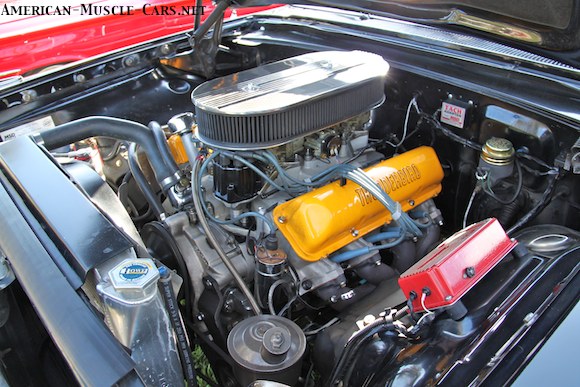
ABOVE: FE-Block For Ford 406 V8 in a 1963-1/2 Galaxy 500, seen here with two 4-barrel carburetors. The 406 was part of the FE family of Ford engines, produced from 1958 through 1976. The were medium-duty engines (not small blocks, and not big blocks), cast in a Y-block configuration, meaning that the block extends well below the centerline of the crankshaft, forming a heavy skirt around the crankshaft, greatly improving strength & rigidity. In its 19-year run, the FE came in a wide range of displacements: 330, 332, 352, 360, 361, 390, 391, 406, 410, 427 & 428. FE was short for “Ford Edsel”, the car that this engine was originally designed for. The 427 went on to achieve legendary status on NASCAR & other race tracks in the 60s. The 427 Side-Oiler was so named because the lubrication system was set up to feed oil to the crankshaft main bearings first, and from the side, for better oiling. The none Side-Oilers fed the crank from the top, as is normal for most engines. The 428 was both a heavy duty truck engine, and a wicked street rocket when in 428 CobraJet form.
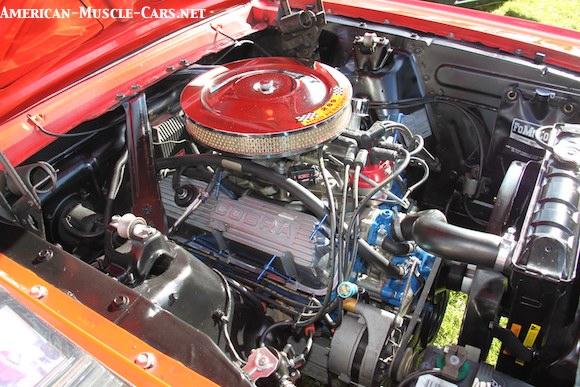
ABOVE: SMALL BLOCK Pictured below is a K-code 289 in a ’66 Mustang. Rated at 271 hp, they were also called “271-horse 289” and “Hi-Po 289”. They were light, compact, powerful for their size, and more than willing to wind, sometimes too willing.

ABOVE: 351 WINDSOR The 351 Windsor, or 351W, was so called because it was built in Ford’s Windsor engine plant in Ontario Canada. This differentiated it from the 351 Cleveland, or 351C, which was built in Cleveland, Ohio, and was a much higher-performance engine than the 351W. The Windsor was based on Ford’s small block V8, basically an enlarged version of the 260, 289 & 302.
BELOW: 428 COBRA JET The biggest version of the FE Block engine family was the 428, and the wickedest version was the 428CJ, or 428 CobraJet, seen here in a ’69 Torino Cobra. They were also used in late-1st-generation Mustangs.
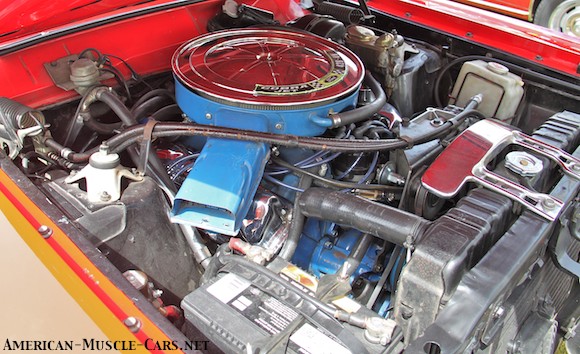
ABOVE: 428CJ IN THE MUSTANG Introduced in the 1968 Mustang, the 428 Cobra Jet engine was the top engine until the Boss 429 came out. The 428CJ was available in 3 flavors. The first had a non-functional hood scoop. The second, a $133 option over the base 428CJ, added the Shaker Hood with functional cold air induction known as the 428 Cobra Jet Ram Air, and included a flapper valve that opened upon flooring the gas pedal, to allow cold outside air into the air cleaner housing. It improved quarter mile times by .2 seconds and added 2mph to the trap speed. It was called a Shaker Hood because the scoop was mounted directly to the top of the engine, extending through a hold in the hood, so that when the engine shook, the scoop shook with it, which was very obvious when it was sticking up through the middle of the hood. The third 428CJ option was known as the Super Cobra Jet Ram Air (429SCJ), which got you lower rear end gearing, 3.91:1 (axle code V) or 4.30:1 (axle code W), and special connecting rods similar to the racing 427s, for high rpm work. The SCJ also got an engine oil cooler which lowered engine oil temperature by 30 degrees. 428CJs were famous for their low-end torque and tended to shred their undersized F70X14 tires, but could still run the quarter mile in the high-13s to mid-14s.
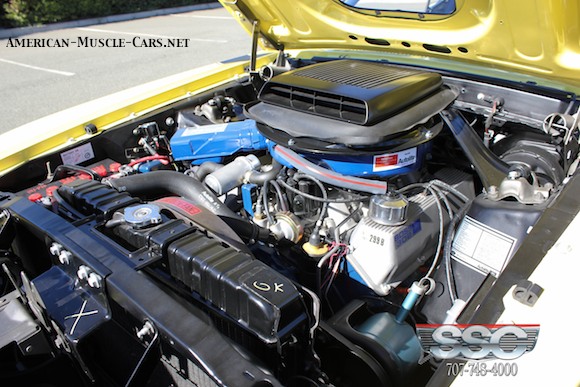
ABOVE: BOSS 302 The Boss 302 V8 was a very special engine. Ford started with the 302 small block, strengthened it, added 4-bolt main bearing caps, a forged steel crankshaft and connecting rods. Redesigned cylinder heads had huge intake and exhaust ports, large, angled valves (2.23” intake and 1.72” exhaust) actuated by adjustable rocker arms. An aluminum high-rise intake manifold mounted a 780cfm Holley 4-barrel carburetor. The cam was sort of a “street & strip” grind with mechanical lifers, which spun a dual-point distributor. With dual exhaust helping it breathe well, this was an engine that loved to wind. Ford installed a rev-limiter to protect it from over-revving, which put a halt to the festivities at 6,150rpm. Without it, the Boss 302 would routinely rev to 7,000rpm with momentary bursts to 7500rpm. It was rated at a conservative 290hp at 5,800rpm and would do the quarter-mile in the high 14-second range, and do 0-60 in less than 7 seconds. But they weren’t just fast, they also handled well, for the times at least. A Boss 302 placed second in the 1969 Trans Am Series, and won it in 1970.
Ford Muscle Cars MODEL-BY-MODEL
The original Pony Car, built on the Falcon chassis. It hit the streets in 1964 as a ’65 model, and rewrote history. It’s been a best-seller ever since, through 5 generations, and heading into its 6th. From lowly 6 cylinders to fire-breathing 428 CobraJets, the Mustang had it all.
From 2-door sports car to bloated 4-door luxo-barge, then back into a 2-door sports car again! All in 10 generations and 50 years. The T-Bird has always been something special!
Ford’s humble midsize car slowly sprouted muscle, big engines & later racing models.
TORINO
Ford’s midsize personal luxury car could also have plenty of muscle, from hot 351 Clevelands to 428 Cobra Jets.
GALAXIE
Ford’s mis-spelled the name of its full-size car on purpose. Big cars, big engines.
Racer-builder Carroll Shelby teams up with Ford starting with the Cobra, then moving into the Shelby Mustangs.
FORD ENGINES
From the Flathead to the new Voodoo, pictures, specs, & history on Ford’s many V8 engine families.


